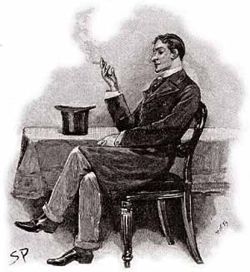Sherlock Holmes
 Sherlock Holmes is undoubtedly the most well-known detective in the world of fiction. He is the main character in four novels and more than fifty short stories by Sir Arthur Conan Doyle. Holmes did not gain instant popularity, but his name eventually spread far beyond Doyle’s native Great Britain to countries around the world. Well over a century after his first appearance in Doyle’s work, Holmes remains an international icon. He not only maintains a base of loyal followers, but has influenced the manner in which law enforcement professionals conduct their investigations. His emphasis on forensic evidence has proven to be a lasting inspiration for real-life detectives and the public alike. Sherlock Holmes is undoubtedly the most well-known detective in the world of fiction. He is the main character in four novels and more than fifty short stories by Sir Arthur Conan Doyle. Holmes did not gain instant popularity, but his name eventually spread far beyond Doyle’s native Great Britain to countries around the world. Well over a century after his first appearance in Doyle’s work, Holmes remains an international icon. He not only maintains a base of loyal followers, but has influenced the manner in which law enforcement professionals conduct their investigations. His emphasis on forensic evidence has proven to be a lasting inspiration for real-life detectives and the public alike.
The Man Behind Sherlock Holmes
Sir Arthur Conan Doyle is mainly known for his work as a writer, even though he was a trained physician as well. He was born in Scotland in 1859 and studied medicine at the University of Edinburgh. It was at the University of Edinburgh that Doyle encountered Joseph Bell, a professor who was well-known for his ability to reason deductively in making diagnoses. Bell is universally believed to have been Doyle’s inspiration for Sherlock Holmes. Doyle began writing his first novels and short stories in the early 1880s as he struggled to establish his own medical practice. Doyle was an avid supporter of the Boer War (1899-1902), writing a pamphlet in support of the British military’s actions against the Dutch in South Africa and even traveling there to serve as a voluntary doctor for British troops. He was also an advocate for social justice and was particularly outspoken against the sufferings of the people of the Belgian Congo. Doyle became deeply interested in ghosts and the afterlife after the deaths of his first wife and son in 1906 and 1918, respectively. He considered himself to be a Christian spiritualist, following the teachings of Christ even as he pursued an interest in the paranormal. Doyle died in London in 1930.
Introduction of Sherlock Holmes into Literature
Readers first became familiar with Sherlock Holmes in 1887, when he appeared in Doyle’s novel A Study in Scarlet. Holmes’ character did not initially receive a significant amount of positive attention. In 1890, an American publisher offered Doyle a contract for The Sign of Four, another mystery novel that featured Holmes. This introduced a few more readers to Holmes’ character, but it still did little to increase Holmes’ overall popularity. For some reason, members of the general public simply did not seem to find Holmes’ first two literary appearances very awe-inspiring. Everything changed for Detective Sherlock Holmes, however, when Doyle’s first short stories featuring the character were published in The Strand Magazine in 1891. Holmes suddenly won the affection of the public, and Sir Arthur Conan Doyle found himself bombarded with requests to write more about the detective. By 1927, Holmes had been featured in a number of additional short stories and in two more novels, The Hound of the Baskervilles and The Valley of Fear.
Background and Personality of Sherlock Holmes
Sherlock Holmes enthusiasts estimate that the fictional Holmes was born in England around 1854. He became interested in detective work during his time at a university and went on to choose a career as a “consulting” detective. According to Arthur Conan Doyle’s books and stories, Holmes is a man of about six feet in height, with sharp eyes and a very unique personality. He often has a messy appearance and is described as a creature of strange habits. He has a tendency of storing items in his shoes, refusing to eat for days, and refusing to throw away any of his hundreds of papers. Somehow, he always manages to find logic in his disorganization. Holmes smokes a pipe and frequently uses cocaine. He firmly believes in protecting his clients at any cost, even if it means lying to the police or breaking into a residence. Despite these displays of loyalty, Holmes is generally an unsocial person. With the exception of his assistant, Watson, he does not care to have many friends. Holmes can be viewed as an arrogant and self-assured individual. Like any good detective, however, he is intelligent, observant, and thorough--and never goes anywhere without his magnifying glass. Holmes is actually said to have died in one story, only to come back to life in another and begin pursuing additional cases.
The Work of Sherlock Holmes
Sherlock Holmes works for an assortment of clients as a private investigator. He deals with a wide variety of cases, which range from finding hidden treasure to solving murders. Most of his cases take place in London and in other parts of England, although one case takes him to Switzerland. His vast knowledge and extraordinary intuition enable him to solve every crime that is placed before him. Holmes is well-known for his use of deductive reasoning in solving crimes. He observes the smallest of details, from fingerprints to cigar ashes, and quickly forms conclusions about what must have happened; only in rare instances does he fail to correctly analyze his clues right away. Sherlock Holmes is famous for wearing disguises while performing investigations. Sometimes, he also needs to make use of his pistol or of his talent in performing hand-to-hand combat.
Relationship Between Sherlock Holmes and Dr. Watson
Dr. Watson is Sherlock Holmes’ closest friend, as well as his assistant. Watson and Holmes are roommates before Watson is married and again after Watson is widowed. Watson serves an important role because he is the narrator of the Sherlock Holmes books and stories; in other words, he chronicles the way in which Holmes solves cases. Watson accompanies Holmes on his investigations and serves as his guard and messenger. Holmes sometimes thinks that Watson does not chronicle the investigations in a way that is scientific enough; however, it is evident that Holmes truly cares about Watson as a friend and values his help. Holmes is famously quoted as saying, “Elementary, my dear Watson.” In Doyle’s books and stories, however, Holmes declares his conclusions to be “elementary” and separately refers to Watson as “my dear Watson.”
Influence and Legacy
Although Sherlock Holmes is a fictional character, his thorough method of investigating a crime scene has had significant influence in the way real-life investigators handle their cases. In his investigations, Holmes places an emphasis upon looking for fingerprints and footprints, as well as performing chemical analysis. He also believes that it is vital to not contaminate a crime scene. Holmes’ methods were not very common in Arthur Conan Doyle’s time, but today they are standard for law enforcement teams in many countries. The character of Sherlock Holmes influenced other writers, including Agatha Christie, to create their own fictional detective characters. There are several museums dedicated to Sherlock Holmes, most notably the Sherlock Holmes Museum in London. A number of plays and movies have been made about Holmes over the years; the most recent films debuted in 2009 and in 2011. Sherlock Holmes still has millions of fans around the world; some of these fans even organize groups that travel to the locations of his fictional cases.
This article was written by Mike Haldas, co-founder and managing partner of CCTV Camera Pros. If you found it useful, please share it.
|









 Sherlock Holmes is undoubtedly the most well-known detective in the world of fiction. He is the main character in four novels and more than fifty short stories by Sir Arthur Conan Doyle. Holmes did not gain instant popularity, but his name eventually spread far beyond Doyle’s native Great Britain to countries around the world. Well over a century after his first appearance in Doyle’s work, Holmes remains an international icon. He not only maintains a base of loyal followers, but has influenced the manner in which law enforcement professionals conduct their investigations. His emphasis on forensic evidence has proven to be a lasting inspiration for real-life detectives and the public alike.
Sherlock Holmes is undoubtedly the most well-known detective in the world of fiction. He is the main character in four novels and more than fifty short stories by Sir Arthur Conan Doyle. Holmes did not gain instant popularity, but his name eventually spread far beyond Doyle’s native Great Britain to countries around the world. Well over a century after his first appearance in Doyle’s work, Holmes remains an international icon. He not only maintains a base of loyal followers, but has influenced the manner in which law enforcement professionals conduct their investigations. His emphasis on forensic evidence has proven to be a lasting inspiration for real-life detectives and the public alike.
